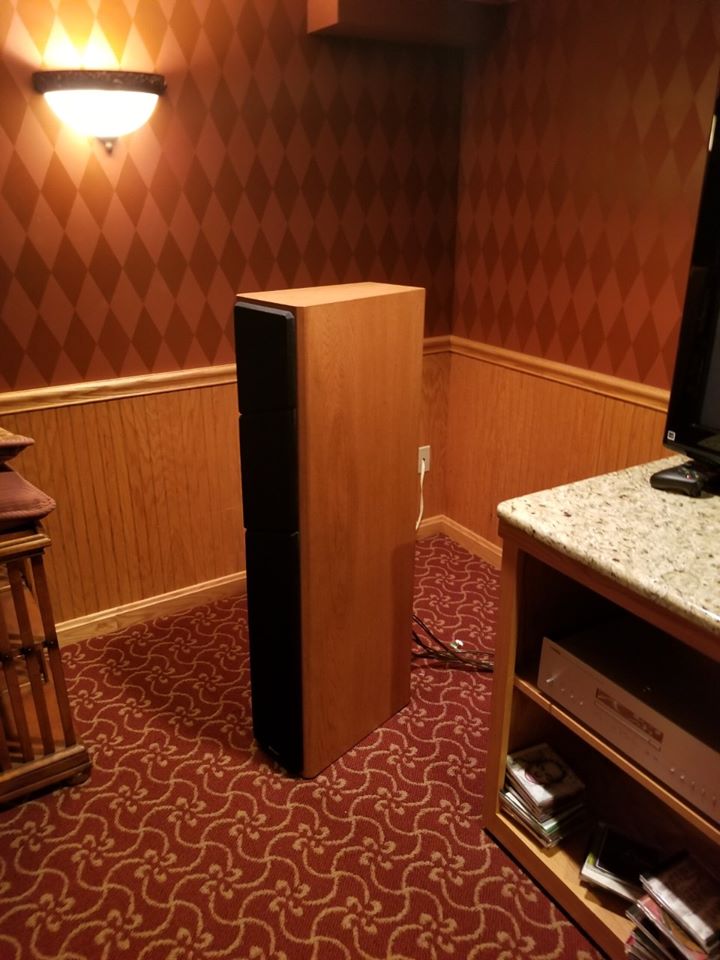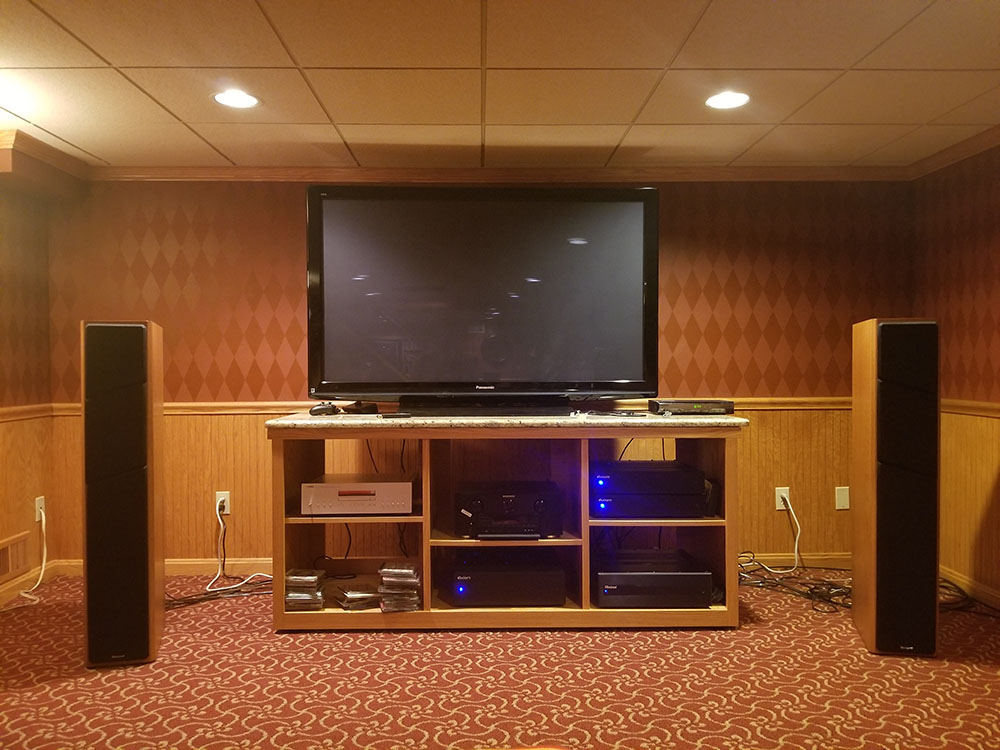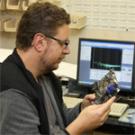I have been an audio nut since the summer of 1977 when I purchased a JVC 35 WPC receiver, a pair of Electro Voice EV-16B speakers (a 12 inch sealed design that was known for embarrassing the Larger Advents for half the price) and a Technics Direct Drive Turntable with a Stanton Cartridge. It was love at first listen – the track was Steve Miller’s long version of “Jet Airliner.” The way the synthesizer panned across the soundstage and the power as the song kicked into high gear with the bass drum and guitars forever changed how I looked at music.
Mom and Dad’s beloved 70 inch wide console system – which we thought was bad ass before, became a joke. This was REAL music, and it was good. I knew sonic nirvana was achieved when my parents renamed my system the “G-D stereo".
Audio became my lifelong hobby. The following year, 1978, I purchased my first high end system. It was the same turntable, but with an upgrade to an 881 Stanton cartridge. The pre-amp was a Marantz 3600 and the power amp was a Marantz 510M – one of the first super amps, capable of pounding out 256 of the best watts one ever heard. Even today this amp is highly sought after, along with its little brother the 250. The speakers were Cerwin Vega’s S-1’s, which were powerful and efficient enough to double as PA speakers for high school dances for which I became the DJ. For my dorm room, I soon added a pair of Koss 1020 speakers, the first speakers I owned that could hit a legitimate 20 Hz, with the S-1’s left for PA duty.
In the 40 years since, I have owned Soundcraftsmen, Carver, Sunfire, Adcom, Aragon, Acurus, McIntosh, Marantz, Emotiva, NAD, Yamaha, Denon…the list goes on…for electronics.
Speakers have included VMPS, Legacy, Paradigm, Klipsch Heritage, Onix Reference, Definitive Technology BP-2000/3000, Energy, Infinity IRS Sigma, Boston Acoustics A-400, Electrovoice Interface: D, Rocket 1000’s, Altec Model 14, OHM Walsh and a host of others. I have also owned many models from Axiom – starting with a pair of bookshelf M22Tis in 2001 through M80Ti, M3 V4, M100 V4, M50 V4 and LFR1100 Omnidirectional speakers.
In 2015, using a passive pre-amp level speaker level matching unit, I spent 3 months doing blind tests between a pair of then $2400 M100’s against the $7000 Legacy Signature SE’s. Much to my surprise, the M100’s won the day (ok, 3 months) under blind listening conditions. This was not just my opinion, but also that of my two musician children – one is an opera singer, the other a classical guitarist. The M100’s just delivered music in an effortless manner that sounded like REAL voices and proper weight and warmth of an acoustic guitar. When one gets to hear the real thing on a regular basis, as I am blessed to be able to do at home, it makes for a compelling comparison for music reproduction in a sound system.
It was after completing the review and comparison of the Legacy’s with the Axiom M100’s that Ian Colquhoun, founder/president of Axiom and someone who is also a proponent of the blind listening test, asked me to try out his new LFR1100’s in our home. The 1100’s take the basic M100 and add rear firing midranges and tweeters along with a DSP to bring together this new concept of the “sound power curve.” There is a wealth of information about this “power curve” concept, which is, 4 years after I received the LFR1100’s, starting to get notice from companies like Magnepan and other high end speaker companies. The basic idea is a sound one (forgive the pun): A speaker with a proper sound curve will have an on axis frequency response that is almost identical to the response “average” of several measurements taking in a sphere of the horizontal and vertical axis of the loudspeaker. The only exception is the power curve will have a gradual roll off above 100 Hz. The speaker with a proper power curve is the speaker will sound more like musical instruments than will a speaker that measures poorly in the power curve measurement.
I received the LFR1100's in late 2015, and for the first 2.5 years, until they were my reference speakers. They then split duty with the Ohm Walsh SSC-4900’s. Both are tremendous speakers, capable of an almost full range sound and a massive sound stage in both width and depth. The Ohms, being an almost crossover-less design (just a supertweeter to extend the highs) having a slight edge in transparency. The Axioms had a large edge in dynamics and flexibility, and are a much easier speaker to drive. Both speakers are capable of bringing that “you are almost there” feel to any music – from Mozart to Guns N Roses.
As good as these speakers are, it was still a thought process that there was a speaker/amp combo that would bring even more of a live experience to the listening room. I auditioned Magnepan 20.7, Magico S-5, B&W Diamond 800 D3 and Goldenear Reference Tritons. Of these, only the Magnepans had that ability to disappear. The only problem with them is they need a huge amp and are really difficult to place.
We are now up to late spring of 2019, and Ian Colquhoun, the founder and president of Axiom Audio, introduces this new active version of the LFR1100. It takes the regular LFR1100 and eliminates the crossover. In its place, it has a DSP with a total of ten different response curves and crossovers – five for each speaker. There is a dedicated amp/dsp for the three 6.5 inch long throw woofers, the two front firing 5.25 inch mids, the two front firing tweeters, the two rear firing 5.25 mids and the rear firing tweeters. Yes, this also means 10 channels of amplification and a fairly complex set up. It also means each driver/amp combo benefits from a limited bandwidth.
Let’s look at one set of drivers: the two front firing 5.25 inch midranges. These two drivers get a dedicated amplifier to cover their operating range from 200 to 2000 Hz. If your music has a powerful kick drum with a fundamental of 40 Hz that taxes the amplifier driving the woofers, it will have no effect on the amp that is driving the mid range driver’s 200-2000 Hz bandwidth. You will have TEN channels of amplification driving these speakers, with NO crossover between the amplifier and the drivers. The added benefit of no phase/loss issues that all crossovers bring to the table made hearing these speakers a compelling thing.
Custom order and woodwork
After making the decision to order the speakers, as has been the case in the past, I had to decide which wood finish I wanted on them. Axiom uses real wood on all their speakers, and I went with a beautiful semi-gloss Oak with a Cinnamon accent. The order was placed, and the waiting began. Also with the order was a pair of Axiom ADA-1500-5 amps – one dedicated five channel amp with 325 watts (8 ohms) available for each of the 5 sets of drivers in each speaker. These amps will deliver 4500 watts on music peaks, and with the fairly high sensitivity of the LFR1100’s, there was high confidence that these speakers would have no issues with dynamics.
They arrived about 6 weeks later, which is pretty good for a custom build speaker pair. The finish is excellent, and the speakers look like big, well made pieces of furniture. They stand four feet tall, so they are going to be noticed. I love the look.

Setting them up
When taking two large speakers, two beast amps, two DSP's, 12 XLR cables, 20 pairs of Banana plugs and cutting 10 sets of speaker wire to put together a “stereo system,” be prepared to spend about three hours putting it all together. It’s more work than the typical system, and there is a sense of pride when you finish the project. The rest of the system is a Marantz 7703 pre-amp processor and a Yamaha CD-S2100 SACD player that measures as well as many $15,000 units, but is only $3000. I love finding great values, and both the Marantz and Yamaha punch well above their price points.
Our main listening room is a great place for listening to speakers. It is 44 feet long and 15 feet wide, with a staircase about 2/3 the way back of the listening position. The walls and floor are concrete, and the ceiling acoustic tile. The carpeting is over a thick pad, and drywall is over 2x4 with thick insulation. The room is very inert, a hand clap will have no echo. When the set up was complete, the speakers were 31 inches from the front wall, 2 feet in from the side walls, and no toe in. The backs of the speakers are angled slightly, and the angle faced out.
FINALLY, it’s time to listen.
How do they sound?
I spend a lot of time listening to unamplified music. My youngest is in his 4th year of a 5 year music program at the university level, and he loves acoustic guitar. He and my daughter also play the piano, and the daughter is also a singer, including opera. I also see live jazz at our country club on a regular basis. Real music is my ultimate comparison for any loudspeaker.
Acoustic Guitar
The first disc was a CD of Acoustic Guitar masters. There is no singing, nor other instruments. It is all guitar without amplification. It was apparent fairly quickly that Axiom was on to something great with these active speakers. Each song had different styles, and the actives presented the weight of the instrument with a naturalness that is impossible to find short of spending a lot more money. This presentation I was hearing reminded me a lot of the Magico S-5 speakers being driven by $40,000 in McIntosh amps. The low end when the performer struck the body of the guitar was there, but without any unnatural boom. I decided the disc warranted a second listen, but this time, I walked around the room. No matter where I went, it was a guitar that I heard. This is where the power sound curve, or what Ian Colquhoun calls the family of curves, shows its mettle.
Pink Floyd "Pulse"
I have been a Pink Floyd fan since my college days. Pulse has been a long time favorite as the band added some extra funk to the sound. The Active LFR1100’s rocked this CD without the need for a subwoofer. The sound effects are incredible – I thought the chopper was inbound. Is there ANYONE who doesn’t know that chopper? No system has ever done what the actives did with this effect. With two speakers, the helicopter flew in from behind you, and finally settled between the speakers. The hard driving bass on “Learning to Fly” was rendered with almost subwoofer level power. And it was TIGHT – no overhang at all.
The Cowboy Junkies "Trinity Session"
This is another classic disc for review. Once again, it is un-amplified music captured by a single microphone at Toronto’s Church of the Holy Trinity. When Margot starts singing “Mining for Gold,” she is in the room. This is a song that makes ordinary speakers sound ordinary. For the first time, I was hearing Margot sound like herself, even when walking to the sides of the speakers. Most make her sound suddenly muffled when off axis, but the Actives let her sing, no matter where you were sitting – or standing. The disc then goes to “Misguided Angel,” which is a haunting song about a woman who finds her man, faults and all, and is telling her family why he is her “one.” It’s an emotional song, and the Actives gave me goose bumps. The rest of the disc is stellar, and once again, I found the actives brought music to life.
I was now grading the recording!
It was after 3 discs that I realized that I was starting to review the recording and its level of quality instead of the quality of the speakers. For example, the SACD of Pink Floyd’s Dark Side of the Moon doesn’t come close to the Pulse CD, in terms of sound quality. I tried Bob Seger’s Live Bullet album. On the actives, it is blatantly obvious that the performance was recorded on multiple microphones. The audience is actually on stage with Seger in the presentation. This was not natural, but it was fun. It didn’t matter what disc I played, the Actives were giving me what the engineers put on the disc.
This is what makes the Actives so special – they deliver music. I could go on about the 100 other discs I have tried with these speakers, but instead I encourage you to try a pair for yourself. If you love music as much as I do, you may find these are the last speakers you need to purchase. They are that good.
Thank you Craigsub for sharing your passion for audio and your LFR1100 Active experience with us! If you'd like more information on the amazing LFR1100 Actives click here.
If you have your own story to share about your audio beginnings and your history with Axiom Audio, we'd love to hear from you!





